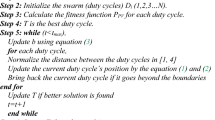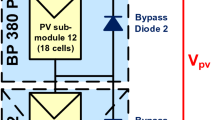Abstract
The performance of solar photovoltaic (PV) panels is entirely determined by ambient temperature, solar irradiance, and dynamic environmental conditions. As a result, the photovoltaic system exhibits multiple peaks in the I-V and P-V curves during partial shading conditions (PSC), which significantly reduces power output. The maximum power point tracking (MPPT) method is essential for extracting maximum power from the PV panel during PSC. With conformist MPPT algorithms, determining the maximum power point is unrealistic. To overcome the constraints, this paper proposes the grasshopper optimisation algorithm (GOA), which imitates the behaviour of grasshopper swarms in nature and is capable of extracting maximum power even during unfavourable shading conditions. The performance assessment of GOA method has been carried out in the MATLAB/SIMULINK environment. This algorithm effectiveness is validated by comparing its performance with conventional and other most prominent global search counterparts. The proposed algorithm is validated in real-time hardware with boost converter through different PV array pattern. The outcome demonstrates the effectiveness of the proposed algorithm which drastically reduces the computation time and performs rapidly and precisely to extract the global maximum peak with minimal oscillations.
























Similar content being viewed by others

References
Abdolrasol MG, Hussain SS, Ustun TS, Sarker MR, Hannan MA, Mohamed R, Milad A (2021) Artificial neural networks based optimization techniques: a review. Electronics 10(21):2689
Aihua G, Yihan X, Rezvan A (2022) Performance improvement of maximum power point tracking for photovoltaic system using grasshopper optimization algorithm based ANFIS under different conditions. Optik 270:169965
Algorithm KE (2017) Maximum power peak detection of partially shaded PV panel by using intelligent monkey maximum power peak detection of partially shaded PV panel by using intelligent monkey king evolution algorithm. IEEE Trans Ind Appl 53:1–6
Bendib B, Belmili H, Krim F (2015) A survey of the most used MPPT methods: conventional and advanced algorithms applied for photovoltaic systems. Renew Sustain Energy Rev 45:637–648. https://doi.org/10.1016/j.rser.2015.02.009
Di Piazza MC, Luna M, Petrone G, Spagnuolo G (2017) Translation of the single-diode PV model parameters identified by using explicit formulas. IEEE J Photovolt 7(4):1009–1016
Elobaid LM, Abdelsalam AK, Zakzouk EE (2015) Artificial neural network-based photovoltaic maximum power point tracking techniques: a survey. IET Renew Power Gener 9(8):1043–1063
Koad RBA, Zobaa AF, El-Shahat A (2017) A novel MPPT algorithm based on particle swarm optimization for photovoltaic systems. IEEE Trans Sustain Energy 8(2):468–476
Kollimalla SK, Mishra MK (2014) A novel adaptive P&O MPPT algorithm considering sudden changes in the irradiance. IEEE Trans Energy Convers 29(3):602–610
Kumar N, Hussain I, Singh B, Panigrahi BK (2017a) MPPT in dynamic condition of partially shaded PV system by using WODE technique. IEEE Trans Sustain Energy 8(3):1204–1214
Kumar N, Hussain I, Singh B, Panigrahi BK (2017b) Single sensor based MPPT for partially shaded solar photovoltaic by using human psychology optimisation algorithm. IET Gener Transm Distrib 11(10):2562–2574
Li H, Yang D, Su W, Lu J, Yu X (2018) An overall distribution particle swarm optimization MPPT algorithm for photovoltaic system under partial shading. IEEE Trans Ind Electron 0046:2018
Mansoor M, Mirza AF, Qiang Ling M, Javed Y (2020) Novel grass hopper optimization based MPPT of PV systems for complex partial shading conditions. Sol Energy 198:499–518
Motahhir S, Chouder A, El Hammoumi A, Benyoucef AS, El Ghzizal A, Kichou S, Silvestre S (2020) Optimal energy harvesting from a multistrings PV generator based on artificial bee colony algorithm. IEEE Syst J 15(3):4137–4144
Muktiadji RF, Rushdi AM (2021) Reliability analysis of boost converters connected to a solar panel using a Markov approach. J Energy Res Rev 7(1):29–42. https://doi.org/10.9734/jenrr/2021/v7i130182
Sera D, Mathe L, Kerekes T, Spataru SV, Teodorescu R (2013) On the perturb-and-observe and incremental conductance MPPT Methods for PV systems. IEEE J Photovoltaics 3(3):1070–1078
Shebani MM, Iqbal T, Quaicoe JE (2016) Comparing bisection numerical algorithm with fractional short circuit current and open circuit voltage methods for MPPT photovoltaic systems. In: 2016 IEEE electrical power and energy conference, EPEC 2016, pp 1–5
Sher HA, Murtaza AF, Noman A, Addoweesh KE, Al-Haddad K, Chiaberge M (2015) A new sensorless hybrid MPPT algorithm based on fractional short-circuit current measurement and P&O MPPT. IEEE Trans Sustain Energy 6(4):1426–1434
Sridhar R, Subramani C, Pathy S (2021) A grasshopper optimization algorithm aided maximum power point tracking for partially shaded photovoltaic systems. Comput Electr Eng 92:107124
Suganyadevi MV, Danila Shirly AR (2022) Optimization of power generation costs through soft computing techniques. In: Thangaprakash Sengodan M, Murugappan SM (eds) Advances in Electrical and Computer Technologies: Select Proceedings of ICAECT 2021. Springer Nature Singapore, Singapore, pp 901–913. https://doi.org/10.1007/978-981-19-1111-8_71
Tahmasbi-fard M, Tarafdar-hagh M, Member S, Pourpayam S, Haghrah A (2018) A voltage equalizer circuit to reduce partial shading effect in photovoltaic string. IEEE J Photovolt 8(4):1102–1109
Tang S, Sun Y, Chen Y, Zhao Y, Yang Y, Szeto W (2017) An enhanced MPPT method combining fractional-order and fuzzy logic control. IEEE J Photovolt 7(2):640–650
Tomar A, Mishra S (2017) Synthesis of a new DLMPPT technique with PLC for enhanced PV energy extraction under varying irradiance and load changing conditions. IEEE J Photovolt 7(3):839–848
Author information
Authors and Affiliations
Corresponding author
Rights and permissions
Springer Nature or its licensor (e.g. a society or other partner) holds exclusive rights to this article under a publishing agreement with the author(s) or other rightsholder(s); author self-archiving of the accepted manuscript version of this article is solely governed by the terms of such publishing agreement and applicable law.
About this article
Cite this article
Tamilarasan, T., Suganyadevi, M.V. An improvement of Global Maximum Power Point Tracking Using a Novel Grasshopper Optimisation Algorithm of Photovoltaic System. Iran J Sci Technol Trans Electr Eng (2024). https://doi.org/10.1007/s40998-024-00709-x
Received:
Accepted:
Published:
DOI: https://doi.org/10.1007/s40998-024-00709-x



